Onions, scientifically known as Allium cepa Linn, belong to the Alliaceae family and are a versatile ingredient used in various cuisines worldwide. Onion farming involves the cultivation of Onions, a versatile vegetable used in various cuisines worldwide. Onion farming provides employment opportunities for many people, supporting rural economies and livelihoods.
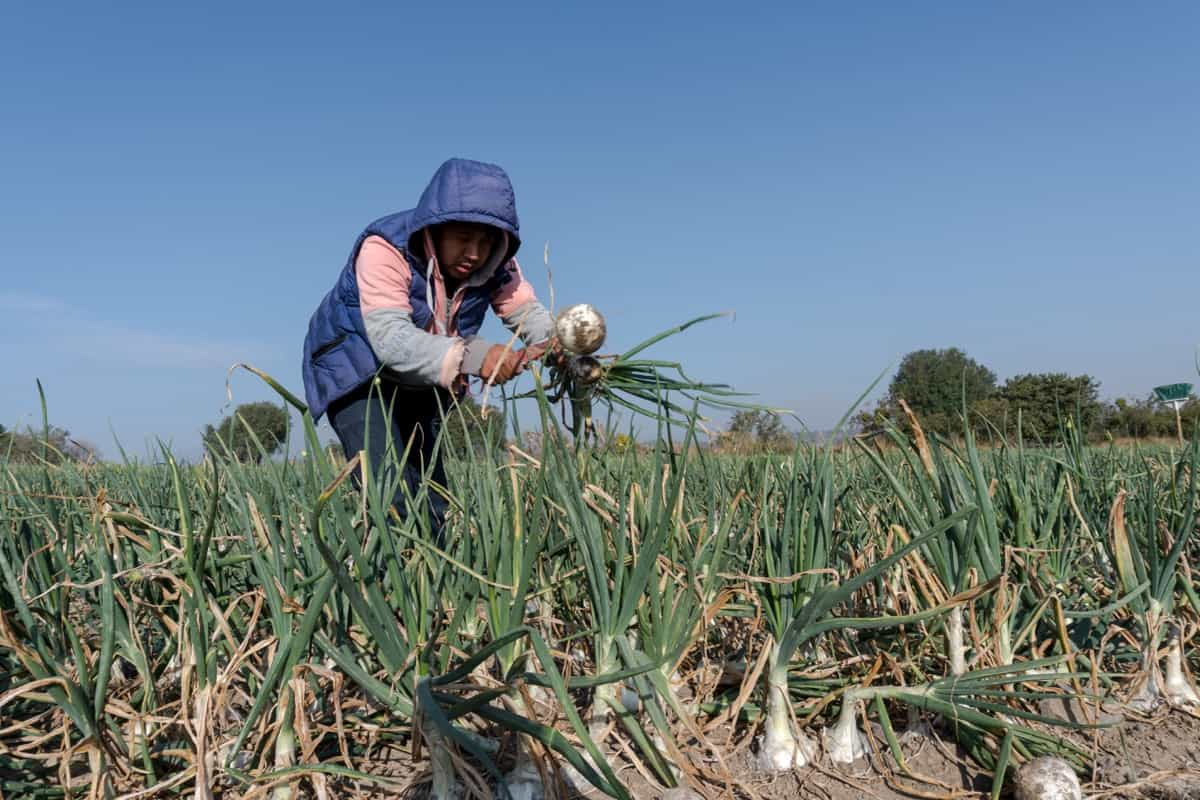
Commercial Varieties of Onions
When it comes to commercial varieties of Onions, there are several options to choose from based on your specific needs and preferences. Some popular choices include Bhima Super, Bhima Dark Red, and Pusa White Flat. Bhima Raj and Bhima Shubhra are also commonly grown varieties known for their high yield potential and disease resistance. Udaipur 102 and Phule Safed are favored for their excellent storage qualities.
Additionally, Agrifound White is a reliable choice for farmers looking for a versatile Onion suitable for various culinary uses. Whatever variety you decide to cultivate, it’s essential to consider some factors, such as market demand, climate conditions, and soil quality, to ensure a successful harvest. In addition to the Bhima series, other notable commercial Onion varieties include Udaipur 102, Phule Safed, N25791, and Agrifound White.
Soil Preparation and Requirements
Onions thrive in well-draining, fertile soil with a pH level between 5.8 and 6.8. Before planting, ensure the soil is free from debris and weeds that can hinder growth. To prepare the soil, plow or till the land to a depth of about 6-8 inches to loosen it up and improve aeration. Onions require adequate nutrients like nitrogen, phosphorus, and potassium for healthy growth. Make a soil test before planting to determine any deficiencies and adjust fertilizer applications accordingly. Avoid waterlogged conditions by ensuring proper drainage in the field.
Seed Selection and Planting Techniques
Selecting high-quality seeds is the first step toward a bountiful Onion crop. Opt for certified Onion seeds from reputable suppliers to guarantee good germination rates and disease resistance. Before Onion planting, prepare the soil by tilling it thoroughly and adding organic matter for nutrient-rich conditions. Onions thrive in well-drained soils with good fertility levels.
In case you missed it: Weed Management in Onion Farms: Control with Organic, Mechanical, Biological, and Herbicides
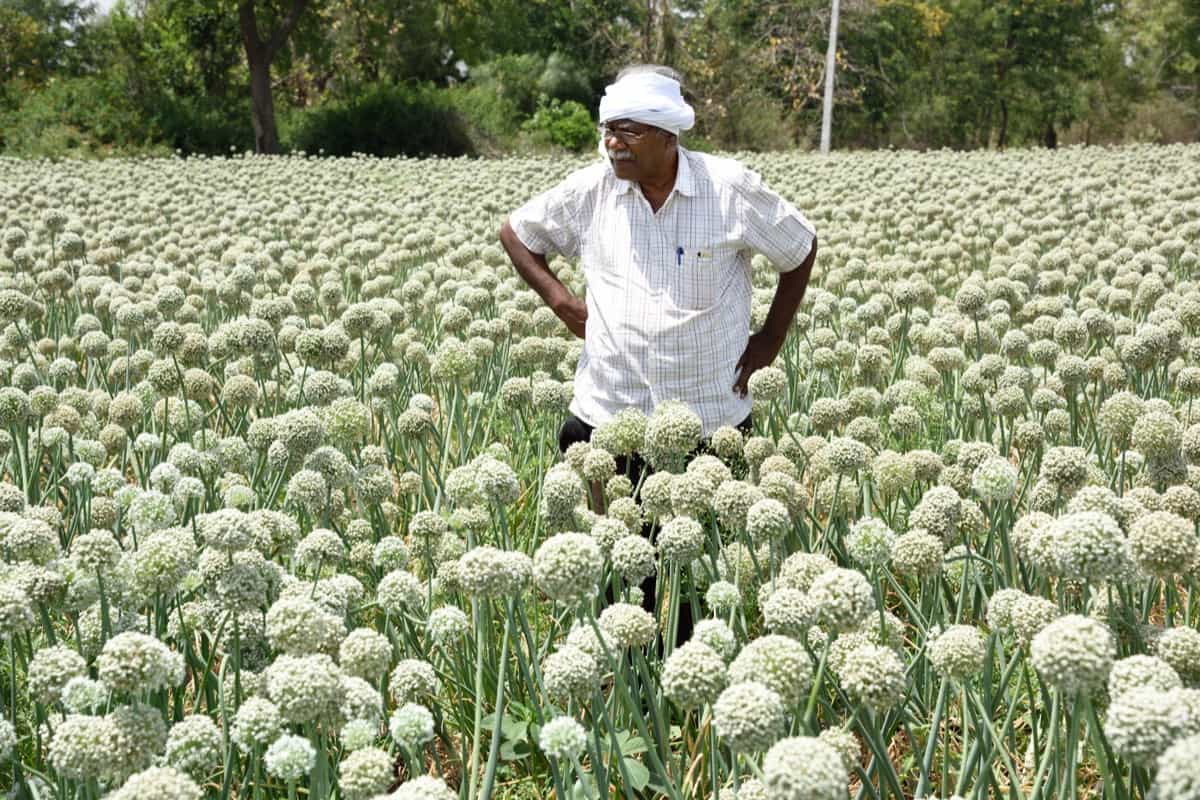
Plant the seeds at the right depth around 1/4 inch deep – and space them adequately to allow room for bulb development. Consider using raised beds or rows for efficient cultivation. Ensure consistent watering after planting to support seed germination and early growth stages. Monitor moisture levels regularly to prevent both under-watering and over-watering issues.
Fertilization and Nutrient Management
Properly nourishing the soil ensures healthy growth and high yields. Before planting, it’s essential to conduct a soil test to determine its nutrient levels. Based on the results, you can then tailor your fertilization plan accordingly. Onions require nitrogen, phosphorus, and potassium for optimal growth. Nitrogen is vital for leaf development, phosphorus promotes root growth, and potassium enhances overall plant health.
Organic sources like compost or manure can be used alongside chemical fertilizers to provide a balanced nutrient supply. Applying fertilizers at the right time during different growth stages is key to maximizing crop productivity. Over-fertilizing can lead to environmental issues and reduced yield quality. Therefore, following recommended dosage guidelines is important for sustainable cultivation practices.
Irrigation Methods for Optimal Growth
Onions require consistent moisture levels to thrive, especially during their early stages. Drip irrigation is a popular method used by many farmers as it delivers water directly to the roots, minimizing water wastage and reducing weed growth in the field. Another effective irrigation method for Onions is furrow irrigation, where water is distributed along shallow channels between rows of crops. This technique helps maintain soil moisture levels while preventing excess water accumulation around the plants.
Weed Control Strategies
Weeds compete with Onions for nutrients, water, and sunlight, affecting their growth and yield. To effectively manage weeds in your Onion field, consider implementing both cultural and mechanical methods. The main strategy is to practice regular cultivation to disrupt weed growth and prevent them from establishing deep roots.
In case you missed it: Best Season to Grow Onions at Home in India: in Pots, Terrace, Apartment Balcony, and Backyards
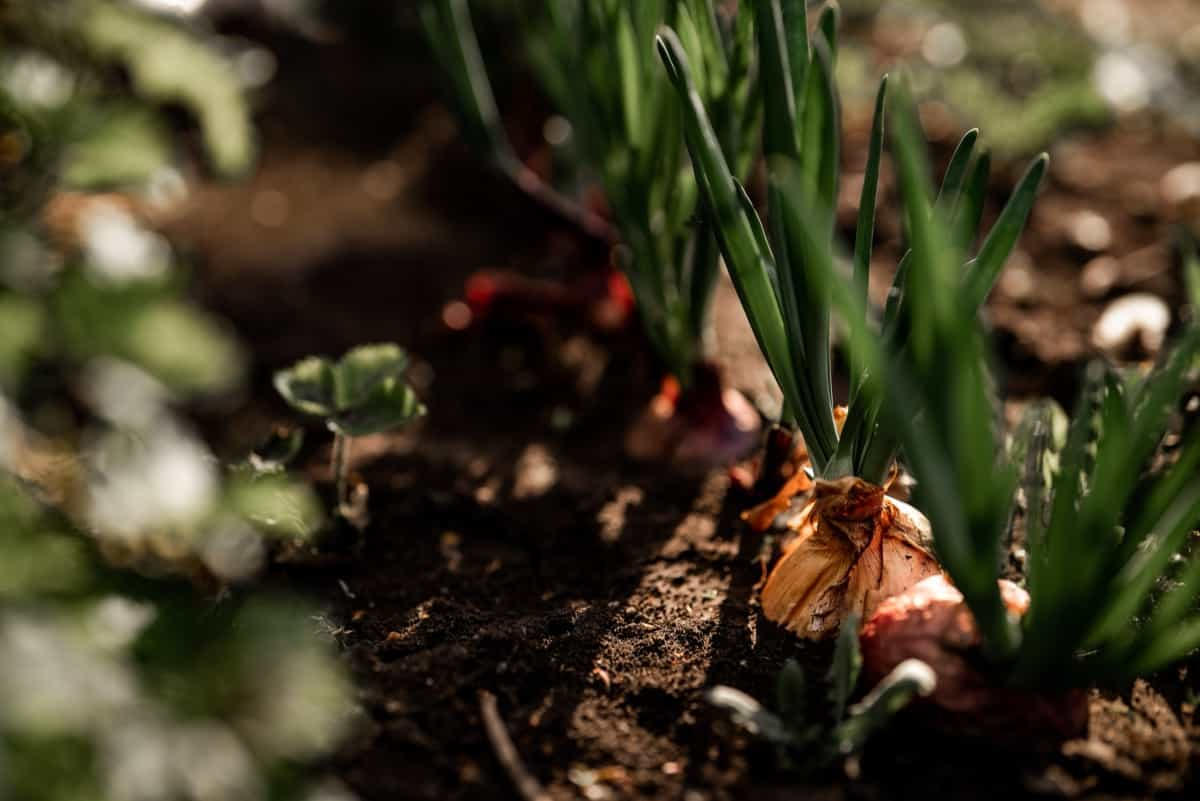
Mulching can also help suppress weeds by making a barrier between the soil surface and sunlight. Additionally, using herbicides selectively can target specific weed species while minimizing harm to your Onion crop. Be sure to follow the instructions carefully when applying herbicides to avoid any negative impact on the environment or human health.
Pest and Disease Management
Pests and diseases can affect Onion yield and quality. It’s important to implement effective management strategies to safeguard your harvest. Some common pests to watch out for include Onion thrips, aphids, and Onion maggots. These small insects can cause significant damage if not properly controlled. Diseases such as downy mildew, white rot, and pink root can also pose a threat to your Onion crop. It’s crucial to monitor your plants regularly for any signs of discoloration, wilting, or unusual growth patterns that indicate the disease.
Regular scouting of your field can help in the early detection of any pest or disease infestations Utilizing integrated pest management techniques such as crop rotation, using resistant varieties, and practicing good sanitation can help reduce pests and diseases. Fungal diseases like downy mildew and bacterial infections such as Onion smut can be controlled through proper irrigation practices, ensuring good air circulation and avoiding overhead watering, which may promote disease spread.
Growth Stages and Crop Monitoring
Onions go through various stages, from seedling to maturity, each requiring specific care and attention. It starts with germination, followed by leaf development, bulb formation, and finally maturation.
Germination: This is the first stage, during which the seed absorbs water and begins to sprout. Given the right conditions of moisture, warmth, and light, it usually takes about 7-10 days for seeds to germinate.
Leaf Development: After germination, the Onion seedling will start to develop its first set of true leaves. During this stage, the seedling focuses on establishing a strong root system and developing its green foliage. Adequate watering and light are essential to support healthy leaf growth.
In case you missed it: How to Start Onion Farming in the USA: A Step-By-Step Guide to Planting to Harvesting
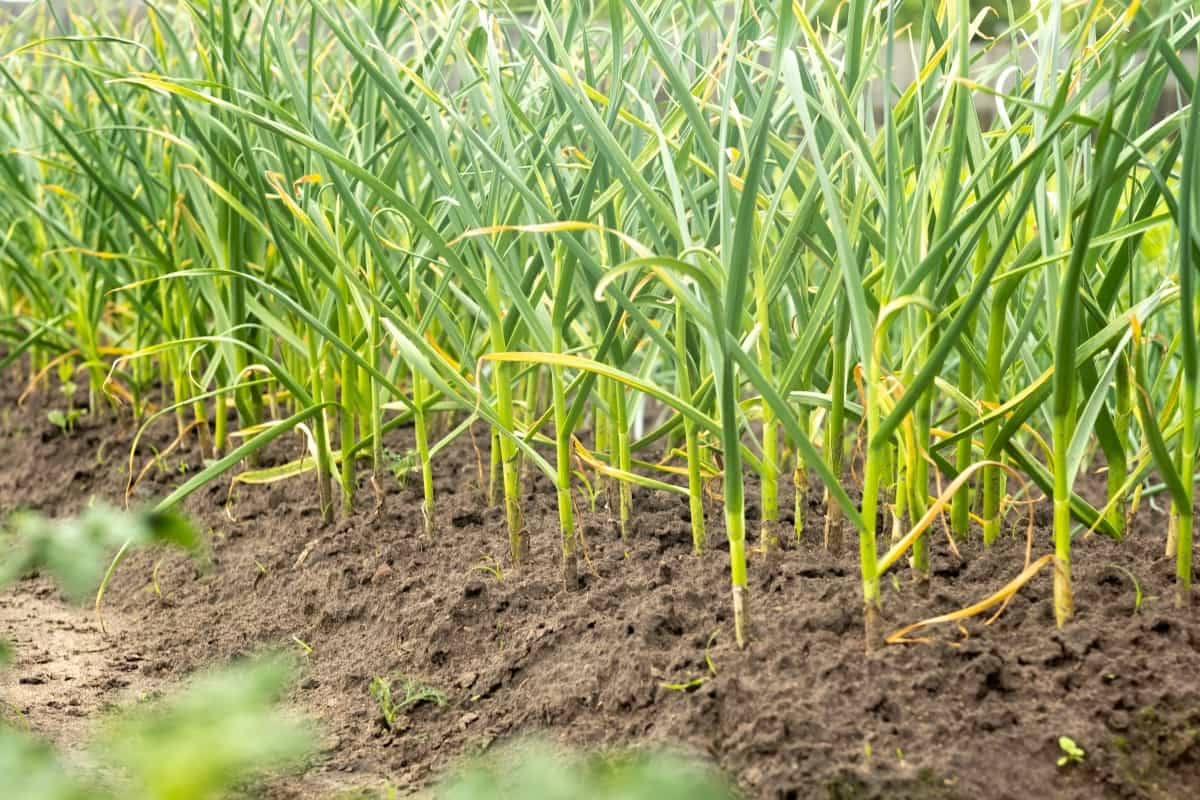
Bulb Formation: Once the Onion plant has developed a certain number of leaves, it begins to allocate energy towards bulb formation. This typically occurs when the days start to lengthen, triggering the Onion to transition from vegetative growth to bulb formation. Factors such as day length, temperature, and soil fertility play crucial roles in determining bulb size and quality.
Maturation: As the Onion bulb continues to grow, it gradually matures and reaches its full size. The foliage above ground will begin to yellow and wither as the bulb matures and prepares for harvest. The timing of maturation varies depending on the Onion variety and environmental conditions.
Monitor the foliage for any signs of discoloration or wilting, which could indicate nutrient deficiencies or pest infestations. Regularly check for weeds competing with your Onion crop for resources like sunlight and moisture. Remove any weeds to prevent them from affecting the growth of your Onions.
Crop monitoring involves regular inspection for signs of pests, diseases, or nutrient deficiencies that can hinder Onion growth. By keeping a close eye on the crop’s health and progress, farmers can take timely actions to address any issues that may arise. Proper monitoring also includes tracking environmental conditions such as temperature, moisture levels, and sunlight exposure.
Harvesting Techniques for Onions
When the Onion tops start to bend over and dry up, it’s a sign that they’re ready for harvesting. To ensure proper curing, harvest on a sunny day when the soil is dry. Gently lift the bulbs using a fork or spade, being careful not to damage them.
After harvesting, leave the Onions in the field for 2-3 days to dry out further. This helps improve their storage quality by allowing the outer layers to toughen up. Once dried, cut off any remaining roots and trim back the foliage before storing them in a cool, dry place with good air circulation. Proper handling during harvesting can help maximize your yield and ensure that your Onions last longer in storage.
Expected Yield of Onions
The yield of Onions per acre can change based on soil quality, climate conditions, and cultivation practices. On average, a well-managed Onion farm can yield around 15-20 tons per acre. However, with proper care and attention to detail in soil preparation, seed selection, irrigation methods, weed control strategies, and pest management techniques, this yield can be significantly increased.
It is essential to monitor the growth stages of the crop closely to ensure optimal development and maximize the harvest. By following best practices in Onion farming and implementing sustainable techniques, farmers can improve their yield potential.
Post-Harvest Handling and Storage
Once harvested, Onions should be cured in a well-ventilated area for 2-3 weeks until the necks are completely dry. This process helps them develop a protective layer that extends their shelf life. During curing, remove any damaged or diseased bulbs to prevent the spread of rot. After curing, trim off the plant roots and tops before storing them in mesh bags or crates with good airflow. Please keep them in a dry place, away from direct sunlight and humidity, to prevent sprouting or molding.
In case you missed it: Fertilizer Management for Onion: NPK Ratio, and Micronutrients
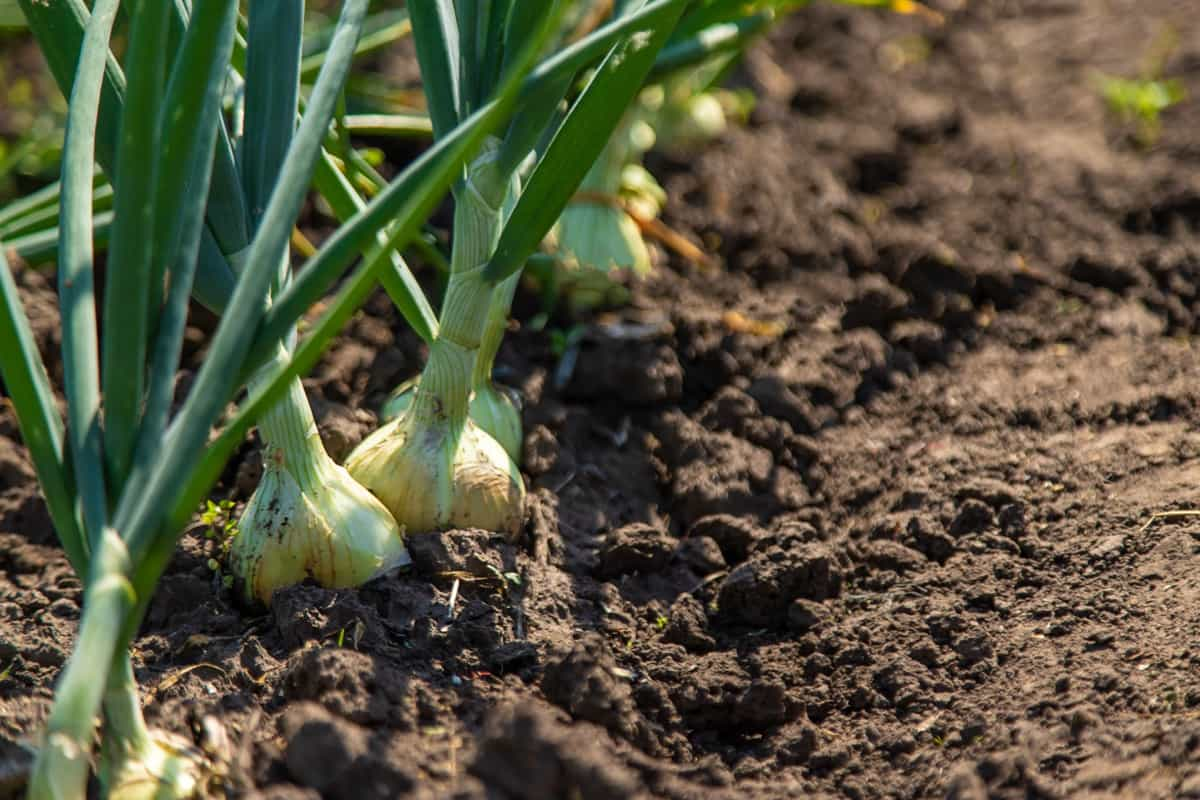
Regularly check stored Onions for any signs of spoilage and remove any affected ones promptly. Properly stored Onions can last for several months, providing you with fresh produce long after the harvest season is over. Mastering post-harvest handling techniques will maximize your Onion yield and profitability.
Economic Analysis and Profitability
Analyzing the costs involved and potential profits can help you make decisions throughout the cultivation process. Calculating the cost of cultivation includes expenses such as seeds, fertilizers, irrigation, labor, and pest management. By keeping track of these costs, you can have a clear picture of your investment in Onion farming. On the other hand, estimating expected profits involves considering factors like market prices, yield per acre, and post-harvest handling.
This allows you to set realistic goals and plan for maximizing profitability in your Onion farm. Economic sustainability plays a significant role in ensuring the long-term viability of your Onion cultivation venture. By continuously evaluating your costs and profits, you can implement strategies to improve efficiency and increase overall profitability over time.
Cost of Cultivation
Onion farming costs can vary depending on factors like seed quality, fertilizer expenses, irrigation methods, and labor charges. On average, the cost per acre for Onion cultivation ranges from Rs. 50,000 to Rs. 70,000.
Expected Profits
The profitability of Onion farming varies depending on factors like yield, market demand, and cultivation costs. With proper management, farmers can expect a decent return on their investment. On average, the profit from cultivating Onions on one acre can range from Rs. 80,000 to Rs. 1,00,000, depending on input costs, market prices, and yields. On average, an acre of well-maintained Onion crops can yield a substantial harvest, translating to promising profits for growers. By optimizing production techniques and minimizing expenses, farmers can maximize their earnings.
Sustainable Practices in Onion Cultivation
Implementing techniques such as crop rotation can help prevent disease buildup and maintain soil fertility naturally. Using organic fertilizers and compost not only enriches the soil but also reduces chemical inputs, promoting a healthier ecosystem. Water management is a key practice of sustainability in Onion farming.
In case you missed it: Top 18 Steps/Ways to Boost Onion Yield: How to Increase Production, Size, and Quality
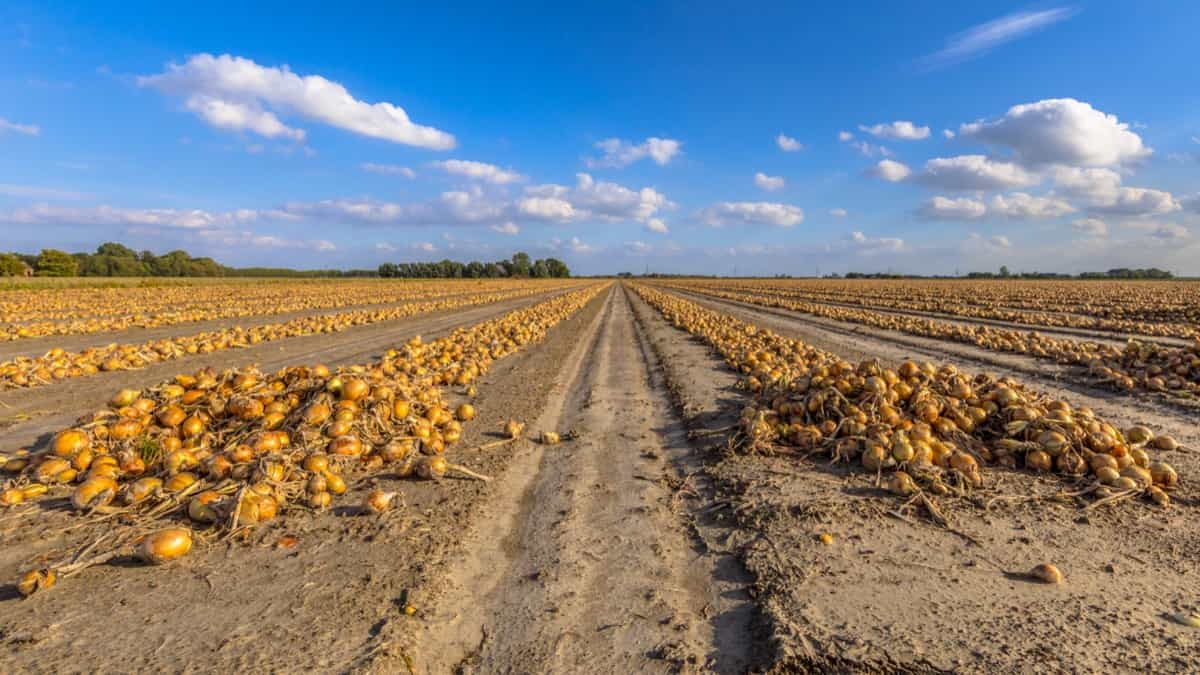
Employing drip irrigation systems or rainwater harvesting methods can help conserve water resources efficiently while ensuring optimal crop growth. Integrated pest management strategies involving beneficial insects and natural predators can effectively control pests without harming the environment. Furthermore, mulching helps retain moisture, suppress weeds, and improve soil structure over time.
Innovations and Technology in Onion Farming
Advancements in agriculture have revolutionized Onion farming, introducing innovative technologies to enhance productivity and efficiency. The use of precision farming techniques such as drip irrigation systems and sensor-based monitoring has significantly improved water management, leading to optimal growth conditions for Onions. Moreover, the integration of drone technology allows farmers to survey their fields with ease, enabling them to identify potential issues like pest infestations or nutrient deficiencies early on. This approach helps in mitigating risks and ensuring a healthy crop yield.
In addition, the adoption of greenhouse cultivation methods provides a controlled environment that protects Onions from adverse weather conditions and pests. This technology also extends the growing season, allowing farmers to cultivate Onions throughout the year. Advancements in seed breeding have led to the development of hybrid Onion varieties that offer higher yields and better resistance to diseases. These innovations contribute towards sustainable Onion farming practices while meeting the increasing global demand for this versatile vegetable.
Tips to Boost Onion Yield
Ensure proper soil preparation by tilling the land and adding organic matter for nutrient-rich soil. When planting, space the Onion sets or transplants properly to allow room for bulb development. Adequate spacing helps prevent overcrowding and competition for resources. Water consistently, but avoid overwatering as it can lead to rotting. Monitor for pests and take prompt action if any issues arise.
Common problems include thrips, Onion maggots, and fungal diseases like white rot. Remember to monitor crop growth stages closely, address any pest or disease issues promptly, and optimize farming practices to ensure a successful harvest. By following these steps to the specific needs of Onion plants, beginners can successfully cultivate Onions and enjoy a bountiful harvest.
- Types of Pesticides Used in Agriculture: A Beginner’s Guide
- Economical Aquaculture: A Guide to Low-Budget Fish Farming
- 15 Common Planting Errors That Can Doom Your Fruit Trees
- How to Make Houseplants Bushy: Effective Tips and Ideas
- Innovative Strategies for Boosting Coconut Pollination and Yield
- Pollination Strategies for Maximum Pumpkin Yield
- The Complete Guide to Chicken Fattening: Strategies for Maximum Growth
- Natural Solutions for Tulip Problems: 100% Effective Remedies for Leaf and Bulb-Related Issues
- Revolutionizing Citrus Preservation: Towards a Healthier, Greener Future
- Natural Solutions for Peony Leaf and Flower Problems: 100% Effective Remedies
- Maximizing Profits with Avocado Contract Farming in India: A Comprehensive Guide
- Natural Solutions for Hydrangea Problems: 100% Effective Remedies for Leaf and Flowers
- The Ultimate Guide to Choosing the Perfect Foliage Friend: Bringing Life Indoors
- From Sunlight to Sustainability: 15 Ways to Use Solar Technology in Agriculture
- The Ultimate Guide to Dong Tao Chicken: Exploring from History to Raising
- The Eco-Friendly Makeover: How to Convert Your Unused Swimming Pool into a Fish Pond
- Mastering the Art of Delaware Chicken Farming: Essentials for Healthy Backyard Flocks
- 20 Best Homemade Fertilizers for Money Plant: DIY Recipes and Application Methods
- How to Craft a Comprehensive Free-Range Chicken Farming Business Plan
- Brighten Your Flock: Raising Easter Egger Chickens for Beauty and Bounty
- How to Optimize Your Poultry Egg Farm Business Plan with These Strategies
- Subsidy for Spirulina Cultivation: How Indian Government Schemes Encouraging Spirulina Farmers
- Ultimate Guide to Raising Dominique Chickens: Breeding, Feeding, Egg-Production, and Care
- Mastering the Art of Raising Jersey Giant Chickens: Care, Feeding, and More
- Ultimate Guide to Raising Legbar Chickens: Breeding, Farming Practices, Diet, Egg-Production
- How to Raise Welsummer Chickens: A Comprehensive Guide for Beginners
- How to Protect Indoor Plants in Winter: A Comprehensive Guide
- Ultimate Guide to Grow Bag Gardening: Tips, Tricks, and Planting Ideas for Urban Gardeners
- Guide to Lotus Cultivation: How to Propagate, Plant, Grow, Care, Cost, and Profit
- Agriculture Drone Subsidy Scheme: Government Kisan Subsidy, License, and How to Apply Online
- Ultimate Guide to Raising Araucana Chickens: Breed Profile, Farming Economics, Diet, and Care
- Bringing Hydroponics to Classroom: Importance, Benefits of Learning for School Students
- Ultimate Guide to Raising Polish Chickens: Breed Profile, Farming Economics, Diet, and Care
- Ultimate Guide to Raising Australorp Chickens: Profile, Farming Economics, Egg Production, Diet, and Care
- Silkie Chicken Farming: Raising Practices, Varieties, Egg Production, Diet, and Care
- Sussex Chicken Farming: Raising Practices, Varieties, Egg Production, Diet and Care
For the seeds, you have mentioned jou need 7-9 kh / ha. What is kh?? Pl explain
It is type (typing mistake) 7 to 9 kg / 1 hectare land.
I’d like to ask about the quantity of yield mentioned above is it the total amount of the whole season
because I’ve been told that onion regrow again in days after harvest and in the same season their are several time of harvest , is that true ?
sir,
I am 35 yrs aged who worked for different educational sectors for 9 yrs and now full time paddy culltivator.I live in village near udupi district ,karnataka state. i have one hectare land and want to try new cultivation which could yeild good profits in lesser time compared to paddy which takes more time and less profit, so i am planning to cultivate onion. As these areas the farmers are not open to other cultivation other than paddy so i always get negative feedback as to its not possible to cultivate any other crop or so. So request you to kindly guide me if i could cultivate as the ph level in udupi distrcit is around 6-7 and the land is not too watery or not too dry and there is a small water body where it can be used to irrigate. Please Guide.
yes done Onion crop after harvesting of Paddy (if Irrigation Facilities available) commonly Ruby season onion plantation mid December to mid January
What breed of onion is sweet with high sugar content for raw eating/salad? I do recall white onion is sweet and mild which breeds would fit that category. Also where to buy that please do inform.
Great informative article. I would like to start onion farming and may I please know the best way between direct seeding and transplanting seedlings
I’m a small scale farmer I live in Zambia farming in solwezi interested onin farming I need help on the type to plant be tween March tyAugast